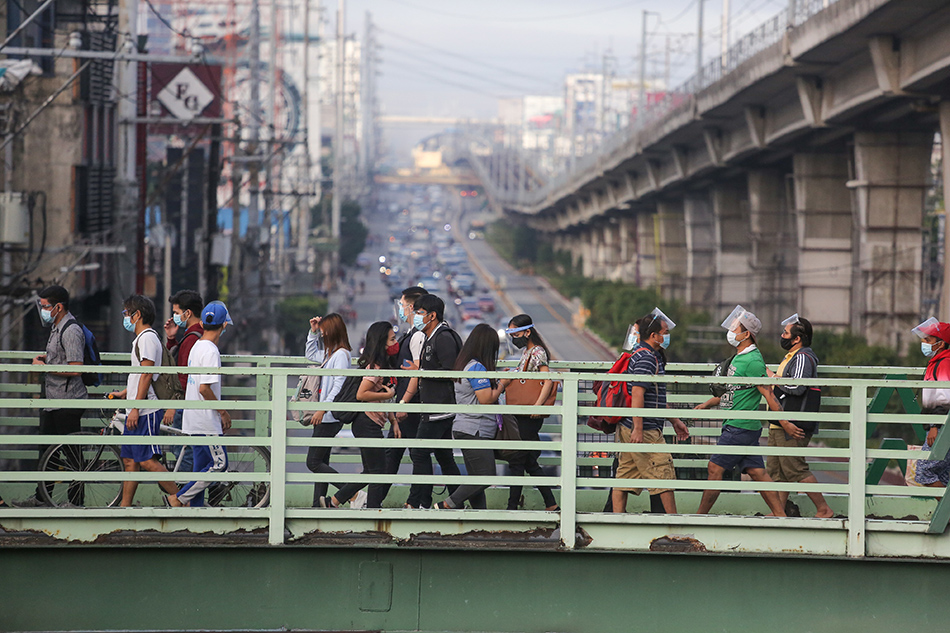NEDA wants public transport capacity increased to 75 percent | ABS-CBN

Welcome, Kapamilya! We use cookies to improve your browsing experience. Continuing to use this site means you agree to our use of cookies. Tell me more!
NEDA wants public transport capacity increased to 75 percent
NEDA wants public transport capacity increased to 75 percent
ABS-CBN News
Published Feb 19, 2021 11:25 AM PHT
MANILA - The National Economic Development Authority on Thursday called for the expansion of public transport capacity to curb the "alarming" hunger incidence in the metro after COVID-19 restrictions affected workers' ability to report to work.
MANILA - The National Economic Development Authority on Thursday called for the expansion of public transport capacity to curb the "alarming" hunger incidence in the metro after COVID-19 restrictions affected workers' ability to report to work.
In a statement, NEDA said it proposed to the Inter-Agency Task Force (IATF) on Emerging Infectious Diseases the increase in public transport capacity to 75 from 50 percent and the expansion of inter-province bus operations to support workers.
In a statement, NEDA said it proposed to the Inter-Agency Task Force (IATF) on Emerging Infectious Diseases the increase in public transport capacity to 75 from 50 percent and the expansion of inter-province bus operations to support workers.
Based on the Google Mobility report as of January 2021, there were 30 percent less people going to work. Some shifted to alternate work arrangements but many "simply have no means to go to work," the agency said.
Based on the Google Mobility report as of January 2021, there were 30 percent less people going to work. Some shifted to alternate work arrangements but many "simply have no means to go to work," the agency said.
Data also showed only 12.5 percent of Filipino households have private cars, NEDA said.
Data also showed only 12.5 percent of Filipino households have private cars, NEDA said.
ADVERTISEMENT
In the National Capital Region (NCR), a hunger incidence rate of 23.3 percent means 1 in 4 people experienced involuntary hunger, NEDA said, citing an SWS November 2020 survey.
In the National Capital Region (NCR), a hunger incidence rate of 23.3 percent means 1 in 4 people experienced involuntary hunger, NEDA said, citing an SWS November 2020 survey.
Meanwhile, areas outside NCR, mostly under modified general community quarantine (MGCQ) generally have lower hunger incidence rates with Mindanao at 16 percent and 14.4 percent in other areas in Luzon and 14.3 percent in Visayas, NEDA said.
Meanwhile, areas outside NCR, mostly under modified general community quarantine (MGCQ) generally have lower hunger incidence rates with Mindanao at 16 percent and 14.4 percent in other areas in Luzon and 14.3 percent in Visayas, NEDA said.
“The data is alarming because we are also seeing a higher hunger incidence in Metro Manila. Many cannot earn because they cannot go to work or lost their jobs, and this means more Filipinos are going to bed hungry,” Acting Socioeconomic Planning Secretary Karl Chua said.
“The data is alarming because we are also seeing a higher hunger incidence in Metro Manila. Many cannot earn because they cannot go to work or lost their jobs, and this means more Filipinos are going to bed hungry,” Acting Socioeconomic Planning Secretary Karl Chua said.
“Prolonged hunger can take away years of productivity and lead to malnutrition which may be passed on to their children and grandchildren. There are also many people who need income and access to hospital care for non-COVID reasons," he added.
“Prolonged hunger can take away years of productivity and lead to malnutrition which may be passed on to their children and grandchildren. There are also many people who need income and access to hospital care for non-COVID reasons," he added.
Chua also said more bike lanes in cities could promote biking as an alternative transport to work.
Chua also said more bike lanes in cities could promote biking as an alternative transport to work.
Public transport was temporarily shut when the COVID-19 lockdown was imposed in 2020 to stem the spread of the disease. Various forms of public transport have since resumed in a limited capacity.
Public transport was temporarily shut when the COVID-19 lockdown was imposed in 2020 to stem the spread of the disease. Various forms of public transport have since resumed in a limited capacity.
RELATED VIDEO:
ADVERTISEMENT
ADVERTISEMENT


